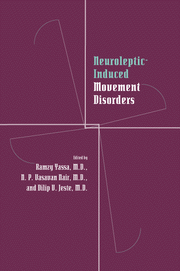Book contents
- Frontmatter
- Contents
- Contributors
- Preface
- Part I Historical perspective
- Part II Clinical aspects of tardive dyskinesia
- Part III Mechanisms underlying tardive dyskinesia
- Part IV Measurement of tardive dyskinesia
- Part V Tardive dyskinesia in different populations
- Part VI Other neuroleptic-induced movement disorders
- 24 Drug-induced parkinsonism
- 25 Clinical aspects of neuroleptic-induced dystonia
- 26 Tardive dystonia
- 27 Tardive akathisia
- Part VII Treatment of tardive dyskinesia
- Index
26 - Tardive dystonia
from Part VI - Other neuroleptic-induced movement disorders
Published online by Cambridge University Press: 09 October 2009
- Frontmatter
- Contents
- Contributors
- Preface
- Part I Historical perspective
- Part II Clinical aspects of tardive dyskinesia
- Part III Mechanisms underlying tardive dyskinesia
- Part IV Measurement of tardive dyskinesia
- Part V Tardive dyskinesia in different populations
- Part VI Other neuroleptic-induced movement disorders
- 24 Drug-induced parkinsonism
- 25 Clinical aspects of neuroleptic-induced dystonia
- 26 Tardive dystonia
- 27 Tardive akathisia
- Part VII Treatment of tardive dyskinesia
- Index
Summary
Shortly after dopamine-receptor blocking agents began to be used for treatment of psychoses in the 1950s, a variety of movement disorders began to be described in the literature and to be attributed to the antipsychotic agents (Crane, 1973). Some of those movement disorders were difficult to treat, and they sometimes persisted after cessation of the antipsychotic treatment (Druckman, Seelinger, & Thulin, 1962). The resulting persistent syndrome, consisting of repetitive oral-buccal-lingual movements (chewing movements; lip puckering, sucking, or smacking; tongue protrusions; side-to-side jaw deviations), was referred to as tardive dyskinesia, and later as classic tardive dyskinesia (Fahn, 1985). The oral-buccal-lingual movements, sometimes accompanied by repetitive limb movements, were labeled “tardive” because they generally appeared only after prolonged treatment with antipsychotics (Faurbye et al., 1964), though there were some reports of persistent movements appearing soon after initiation of therapy (Angle & Mclntire, 1968).
Beginning in 1962, a series of reports appeared describing persistent abnormal movements that resembled the symptoms of idiopathic dystonia and appeared after treatment with neuroleptics (Burke et al., 1982). According to the Scientific Advisory Board of the Dystonia Medical Research Foundation, dystonia is “a syndrome of sustained muscle contractions, frequently causing twisting and repetitive movements, or abnormal postures” (Fahn, 1988). The term tardive dystonia, analogous to tardive dyskinesia, was coined by Keegan and Rajput (1973).
- Type
- Chapter
- Information
- Neuroleptic-induced Movement DisordersA Comprehensive Survey, pp. 395 - 408Publisher: Cambridge University PressPrint publication year: 1996



